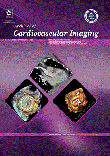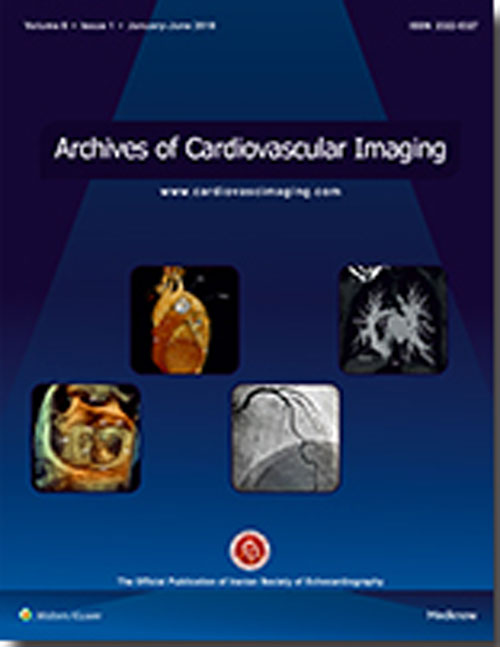فهرست مطالب

Archives Of Cardiovascular Imaging
Volume:3 Issue: 3, Aug 2015
- تاریخ انتشار: 1394/10/12
- تعداد عناوین: 7
-
-
Page 1Acute myocardial infarction can culminate in sudden cardiac death due to cardiogenic shock and ventricular fibrillation, and also rarely due to cardiac rupture. We present a case of post-infarction myocardial rupture after thrombolytic therapy diagnosed with transthoracic echocardiography and treated with direct closure and coronary artery bypass grafting..Keywords: Echocardiographic Cap, Myocardial Rupture, Acute Myocardial Infraction
-
Page 2IntroductionThe incidence of mechanical complications related to myocardial infarction has decreased over the last decades, and revascularization certainly plays a major role in this change. However, mortality still remains elevated. This is a case of acute papillary muscle rupture secondary to myocardial infarction leading to cardiogenic shock..Case PresentationA 71-year-old woman presented to an outside hospital complaining of chest pain and shortness of breath. An electrocardiogram was obtained and revealed depression of the ST segments from leads V1 to V4. Troponin I was elevated at 3.0 ng/mL. She was transferred to our facility for a higher level of care. She was found in cardiogenic shock at arrival. A bedside echocardiogram was ordered, which demonstrated papillary muscle rupture with severe mitral regurgitation. A coronary angiogram followed, which diagnosed severe three-vessel disease. After the insertion of an intra-aortic balloon pump, she was transferred emergently to the surgical suite for mitral valve replacement and revascularization. The operation was uneventful. She was discharged to a rehabilitation center after approximately 1 month of hospital stay..ConclusionsMortality from papillary muscle rupture remains elevated. Survival largely depends on the early surgical repair or the replacement of the mitral valveKeywords: Papillary Muscle Rupture, Acute Mitral Regurgitation, Echocardiography, Cardiogenic Shock, Acute Myocardial Infarction
-
Page 3IntroductionTakayasu’s arteritis (TA) is a chronic, idiopathic, inflammatory disease that affects large elastic arteries, including the aorta and its main branches. No consensus exists currently on the superiority of surgery over endovascular repair (angioplasty with or without stenting) for vascular lesions in TA..Case PresentationA 54-year-old woman with an 11-year history of ankylosing spondylitis (AS) presented with left arm weakness and severe left arm claudication. Duplex ultrasonography of the left upper extremity showed vessel-wall edema of the subclavian, axillary, and brachial arteries. Aortic angiography demonstrated a 70 - 80% stenosis of the left subclavian artery and a long, high-grade stenotic segment of the axillary artery. Intravascular ultrasound (IVUS) of the stenotic subclavian segment showed extensive negative remodeling with minimal plaque formation. The patient responded well to balloon angioplasty on this segment with medical therapy for AS..ConclusionsOur case is the first report of IVUS imaging of subclavian stenosis resulting from Takayasu’s arteritis and provides insight into the pathology behind such lesions..Keywords: Angiography, Other Imaging, Other treatment, Imaging
-
Pages 5-2IntroductionIn patients with acute heart failure, pleural fluid localized in an inter-pleural fissure produces a mass on chest X-ray, which mimics a tumor..Case PresentationSuch masses have been designated as vanishing tumors of the lung. It is extremely rare that a vanishing tumor occurs in the apex of the lung..ConclusionsThis is the first case report of a vanishing tumor in the right pulmonary apex.Keywords: Vanishing Tumor, Heart Failure, X-ray
-
Page 6BackgroundLimited data are available about feasibility and clinical value of left atrium (LA) quantitative evaluation obtained from real time 3D (RT-3D) echocardiography in critically ills..ObjectivesAims of this study were: 1) to evaluate feasibility of RT-3D echocardiography for LA evaluation in an acute care setting and in a population including a majority of critically ills; 2) to evaluate correlation between two-dimensional (2D) and RT-3D echocardiographic LA quantitative evaluation; 3) to assess clinical consistency and prognostic value of LA measurements obtained from RT-3D images in subjects without CV diseases and in patients with AF and CHF, evaluated in the acute phase of the disease..Patients andMethodsIn 382 subjects admitted in the emergency department (ED), we evaluated maximal (Volmax) and minimal (Volmin) LA volumes and LA emptying fraction (LA-EF), from RT-3D images, with a semiautomated border detection program. A follow-up was performed in order to evaluate all-cause mortality and new hospital admission for cardiovascular events..ResultsThe correlation between measures obtained from 2D and 3D was good (LA Volmax: r = 0.896, P < 0.001; Volmin: r = 0.906, P < 0,001; LA EF: r = 0.749, P < 0.001). Among 77 normal subjects, people aged ≥ 65 years demonstrated comparable LA dimensions with younger subjects (LA Volmax: 25 ± 11 vs 20 ± 7 mL/m2, Volmin: 11 ± 7 vs 8 ± 5 mL/m2). Subjects with normal left ventricular ejection fraction showed LA Volmax significantly lower than patients with LV systolic dysfunction or congestive heart failure (23 ± 11 vs 29 ± 10 vs 33 ± 12 mL/m2, P < 0.05). Patients in atrial fibrillation showed a significantly dilated LA compared with subjects in sinus rhytm (24 ± 11 vs 37 ± 22 mL/m2, P < 0.05). LA dimensions were significantly higher in non-survivors (LA Volmax: 33 ± 9 vs 25 ± 9 mL/m2), in patients with a new hospital admission for cardiovascular disease (LA Volmax: 34 ± 13 vs 23 ± 10 mL/m2) or with a new AF episode (LA Volmax: 40 ± 12 vs 24 ± 11 mL/m2, all P < 0.005)..ConclusionsRT-3D evaluation of LA volumes and function is feasible in a non selected series of critically ills. LA dilation was associated with a worse outcome in terms of morbidity and mortality..Keywords: Heart Atria, Atrial Function, Echocardiography, Three, Dimensional, Critical Illness
-
Page 7BackgroundUnderstanding the relation between ventricular-arterial coupling (VAC) and myocardial mechanical parameters could offer an adjunctive perspective on left ventricular function..ObjectivesOur aim was to study the relation between VAC and the parameters of myocardial mechanics using three-dimensional speckle-tracking echocardiography (3DSTE)..Patients andMethodsWe studied 68 normal participants (mean age, 35 ± 12.2 y; 36 [53%] males). VAC was measured by the ratio of arterial elastance (Ea) to ventricular elastance (Ees). The peak systolic value of longitudinal strain (LS), circumferential strain (CS), radial strain, three-dimensional global strain (3DGS), apical rotation, torsion, and twist and their time to peak were calculated..ResultsAlmost all deformation indices were higher in the women than in the men. LS (r = -0.41, P < 0.01), twist (r = 0.26, P < 0.03), rotation (r = 0.41, P < 0.01), and 3DGS (r = - 0.39, P < 0.01) were associated with age. Although significant associations were found between VAC and Ea or Ees in the men and women, no relation was found between Ea and Ees in both sexes (r = 0.07 in men and r = 0.08 in women). Indeed, VAC had a stronger association with Ea than with Ees (r = 0.708 vs. r = -0.537). Ees and VAC were related to torsion (r = 0.30 vs. r = -0.37; both P < 0.05); and Ea, Ees, and VAC were also associated with CS (r = 0.64, r = -0.45, and r = 0.79; all P < 0.05) and 3DGS (r = -0.55, r = 0.38, and r = -0.64; all P < 0.01)..ConclusionsAmongst all myocardial mechanical parameters, VAC was related to CS and 3DGS as well as torsion..Keywords: Ventricular, Arterial Coupling, Myocardial Mechanical Parameters, Three, Dimensional Speckle, Tracking Echocardiography


